
The Ring Nebula is a planetary nebula in the northern constellation of Lyra. Such a nebula is formed when a star, during the last stages of its evolution before becoming a white dwarf, expels a vast luminous envelope of ionized gas into the surrounding interstellar space.

Monoceros is a faint constellation on the celestial equator. Its definition is attributed to the 17th-century Dutch cartographer Petrus Plancius. It is bordered by Orion to the west, Gemini to the north, Canis Major to the south, and Hydra to the east. Other bordering constellations include Canis Minor, Lepus, and Puppis.

The Cat's Eye Nebula is a planetary nebula in the northern constellation of Draco, discovered by William Herschel on February 15, 1786. It was the first planetary nebula whose spectrum was investigated by the English amateur astronomer William Huggins, demonstrating that planetary nebulae were gaseous and not stellar in nature. Structurally, the object has had high-resolution images by the Hubble Space Telescope revealing knots, jets, bubbles and complex arcs, being illuminated by the central hot planetary nebula nucleus (PNN). It is a well-studied object that has been observed from radio to X-ray wavelengths.

The Eskimo Nebula, also known as the Clown-faced Nebula, Lion Nebula, or Caldwell 39, is a bipolar double-shell planetary nebula (PN). It was discovered by astronomer William Herschel in 1787. The formation resembles a person's head surrounded by a parka hood. It is surrounded by gas that composed the outer layers of a Sun-like star. The visible inner filaments are ejected by a strong wind of particles from the central star. The outer disk contains unusual, light-year-long filaments.

The Saturn Nebula is a planetary nebula in the constellation Aquarius. It appears as a greenish-yellowish hue in a small amateur telescope. It was discovered by William Herschel on September 7, 1782, using a telescope of his own design in the garden at his home in Datchet, England, and was one of his earliest discoveries in his sky survey. The nebula was originally a low-mass star that ejected its layers into space, forming the nebula. The central star is now a bright white dwarf star of apparent magnitude 11.5. The Saturn Nebula gets its name from its superficial resemblance to the planet Saturn with its rings nearly edge-on to the observer. It was so named by Lord Rosse in the 1840s, when telescopes had improved to the point that its Saturn-like shape could be discerned. William Henry Smyth said that the Saturn Nebula was one of Struve's nine "Rare Celestial Objects".

The Lagoon Nebula is a giant interstellar cloud in the constellation Sagittarius. It is classified as an emission nebula and as an H II region.

NGC 6751, also known as the Glowing Eye Nebula or the Dandelion Puffball Nebula, is a planetary nebula in the constellation Aquila. It is estimated to be about 6,500 light-years away.

The Medusa Nebula is a planetary nebula in the constellation of Gemini. It is also known as Abell 21 and Sharpless 2-274. It was originally discovered in 1955 by University of California, Los Angeles astronomer George O. Abell, who classified it as an old planetary nebula. Until the early 1970s, the nebula was thought to be a supernova remnant. With the computation of expansion velocities and the thermal character of the radio emission, Soviet astronomers in 1971 concluded that it was most likely a planetary nebula. As the nebula is so large, its surface brightness is very low, with surface magnitudes of between +15.99 and +25 reported.

NGC 2022 is a planetary nebula in the equatorial constellation of Orion, located at a distance of 8.21 kilolight-years from the Sun. It was first observed by William Herschel on December 28, 1785, who described it as: considerably bright, nearly round, like a star with a large diameter, like an ill-defined planetary nebula. In medium-sized amateur telescopes it looks like a small grayish patch of light. It is not very bright but it is still easy to spot it in the eyepiece. Even in a telescope as small as 80mm it can just be seen using a narrowband filter such as an OIII filter as a 'fuzzy' star. The object has the shape of a prolate spheroid with a major to minor axis ratio of 1.2, an apparent size of 28″, and a halo extending out to 40″, which is about the angular diameter of Jupiter as seen from Earth.
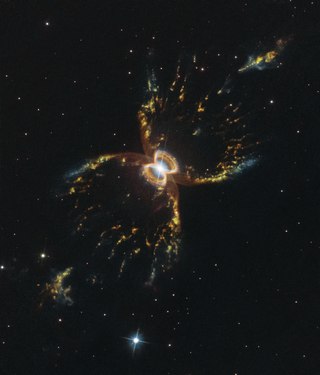
The Southern Crab Nebula is a nebula in the constellation Centaurus. The nebula is several thousand light years from Earth, and its central star is a symbiotic Mira variable - white dwarf pair. It is named for its resemblance to the Crab Nebula, which is in the northern sky.
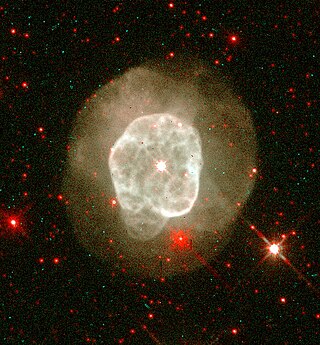
NGC 6578 is a planetary nebula located in Sagittarius. It is magnitude 13.5 with diameter 8 arc seconds. It has a 16th magnitude central star, which is an O-type star with a spectral type of Of. It is seen near the star 16 Sagittarii.
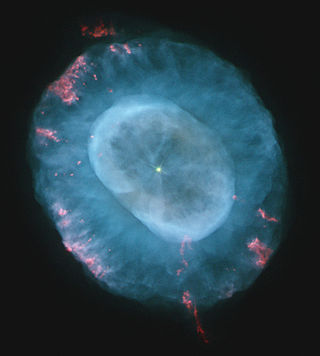
NGC 7662 is a planetary nebula located in the northern constellation Andromeda. It is known as the Blue Snowball Nebula, Snowball Nebula, and Caldwell 22. This nebula was discovered October 6, 1784 by the German-born English astronomer William Herschel. In the New General Catalogue it is described as a "magnificent planetary or annular nebula, very bright, pretty small in angular size, round, blue, variable nucleus". The object has an apparent visual magnitude of 8.3 and spans an angular size of 32″ × 28″. Parallax measurements give a distance estimate of 5,730 ± 340 ly (1,757 ± 103 pc).

NGC 2867 is an elliptical Type II planetary nebula in the southern constellation of Carina, just over a degree to the NNW of the star Iota Carinae. It was discovered by John Herschel on April 1, 1834. Herschel initially thought he might have found a new planet, but on the following night he checked again and discovered it had not moved. The nebula is located at a distance of 7,270 light-years from the Sun.

NGC 3195 is a planetary nebula located in the southern constellation of Chamaeleon. It is the most southern of all the bright sizable planetary nebula in the sky, and remains concealed from all northern observers. Discovered by Sir John Herschel in 1835, this 11.6 apparent magnitude planetary nebula is slightly oval in shape, with dimensions of 40×35 arc seconds, and can be seen visually in telescopic apertures of 10.5 centimetres (4.1 in) at low magnifications.

NGC 3242 is a planetary nebula located in the constellation Hydra.

Little Ghost Nebula, also known as NGC 6369, is a planetary nebula in the constellation Ophiuchus. It was discovered by William Herschel.

IC 3568 is a planetary nebula that is 1.3 kiloparsecs away from Earth in the constellation of Camelopardalis. It is a relatively young nebula and has a core diameter of only about 0.4 light years. It was dubbed the Lemon Slice Nebula by Jim Kaler, due to its appearance in one false-colour image from the Hubble Space Telescope. The Lemon Slice Nebula is one of the most simple nebulae known, with an almost perfectly spherical morphology. The core of the nebula does not have a distinctly visible structure in formation and is mostly composed of ionized helium. A faint halo of interstellar dust surrounds the nebula. The central star of the planetary nebula is an O-type star with a spectral type of O(H)3.
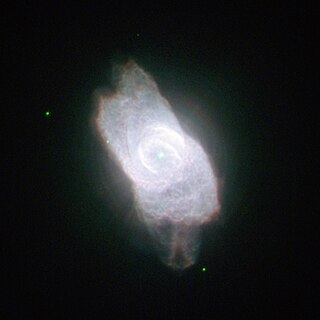
NGC 6572 is a planetary nebula with magnitude 8.1, easily bright enough to make it an appealing target for amateur astronomers with telescopes. NGC 6572 is a young planetary nebula. NGC 6572 began to shed its gases a few thousand years ago. Because of this, the material is still quite concentrated, which explains its abnormal brightness. The envelope of gas is currently racing out into space at a speed of around 15 kilometres per second. As it becomes more diffuse, it will dim. It is located within the large constellation of Ophiuchus and at low magnification, it will appear to be just a colored star, but higher magnification will reveal its shape. NGC 6572 was discovered in 1825 by the German astronomer Friedrich Georg Wilhelm von Struve. According to several sources such as Sky & Telescope, this object received the nicknames Blue Racquetball, Emerald Nebula, Green Nebula, Turquoise Orb.

NGC 1501 is a complex planetary nebula located in the constellation of Camelopardalis, it was discovered on the 27th August 1787 by William Herschel. It is also known as the Oyster Nebula.
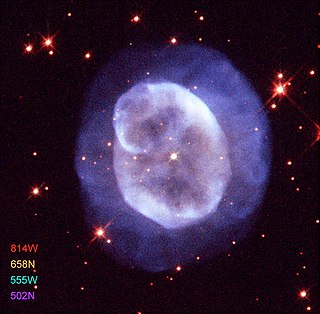
NGC 5979 is a planetary nebula in the constellation Triangulum Australe. It was discovered by John Herschel on April 24, 1835. The central star of the planetary nebula is an O-type star with a spectral type of O(H)3-4.






















